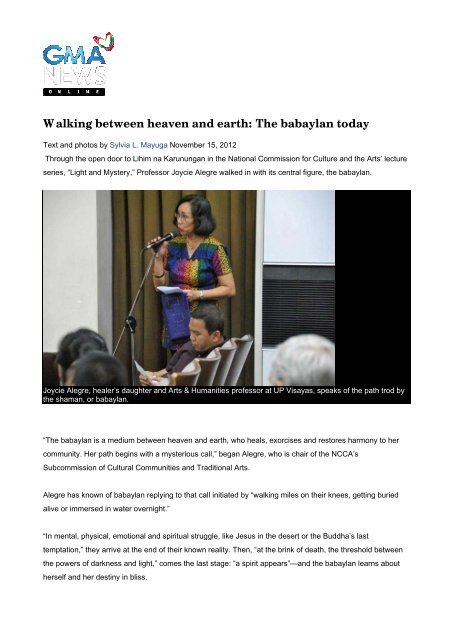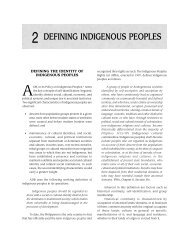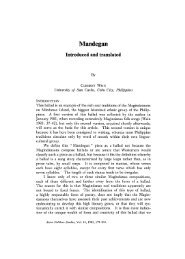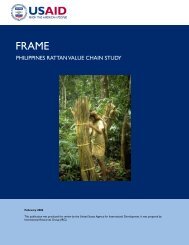Walking between heaven and earth: The ... - Philippine Culture
Walking between heaven and earth: The ... - Philippine Culture
Walking between heaven and earth: The ... - Philippine Culture
You also want an ePaper? Increase the reach of your titles
YUMPU automatically turns print PDFs into web optimized ePapers that Google loves.
<strong>Walking</strong> <strong>between</strong> <strong>heaven</strong> <strong>and</strong> <strong>earth</strong>: <strong>The</strong> babaylan today<br />
Text <strong>and</strong> photos by Sylvia L. Mayuga November 15, 2012<br />
Through the open door to Lihim na Karunungan in the National Commission for <strong>Culture</strong> <strong>and</strong> the Arts’ lecture<br />
series, “Light <strong>and</strong> Mystery,” Professor Joycie Alegre walked in with its central figure, the babaylan.<br />
Joycie Alegre, healer’s daughter <strong>and</strong> Arts & Humanities professor at UP Visayas, speaks of the path trod by<br />
the shaman, or babaylan.<br />
“<strong>The</strong> babaylan is a medium <strong>between</strong> <strong>heaven</strong> <strong>and</strong> <strong>earth</strong>, who heals, exorcises <strong>and</strong> restores harmony to her<br />
community. Her path begins with a mysterious call,” began Alegre, who is chair of the NCCA’s<br />
Subcommission of Cultural Communities <strong>and</strong> Traditional Arts.<br />
Alegre has known of babaylan replying to that call initiated by “walking miles on their knees, getting buried<br />
alive or immersed in water overnight.”<br />
“In mental, physical, emotional <strong>and</strong> spiritual struggle, like Jesus in the desert or the Buddha’s last<br />
temptation,” they arrive at the end of their known reality. <strong>The</strong>n, “at the brink of death, the threshold <strong>between</strong><br />
the powers of darkness <strong>and</strong> light,” comes the last stage: “a spirit appears”—<strong>and</strong> the babaylan learns about<br />
herself <strong>and</strong> her destiny in bliss.
“But she must decide whether to be a sorceress, a healer or a combination of both, <strong>and</strong> return to <strong>earth</strong> to<br />
fulfill her mission,” Alegre said. If she assents, she makes a “panata—a vow, a pledge, a sacrifice or an<br />
offering,” <strong>and</strong> becomes a full-fledged babaylan.<br />
Babaylanes rife in Alegre’s native Eastern Visayas are called tambalan. Her mother is one—healing, reciting<br />
special prayers, performing rituals to ward off evil.<br />
Alegre speaks of Capul Isl<strong>and</strong>’s tambalan with special fascination. Tiny Capul off Northern Samar, in the<br />
path of the Spanish galleons of yore, is an anthropologist’s dream. Its name is short for Acapulco, center of<br />
the old galleon trade; its natives trace their roots to the Sama tribe of Sulu, master boatbuilders well known<br />
for their shamanism dating back to our Austronesian past.<br />
Sama roots could well be why Capul has such a rich variety of tambalan: snakebite healers, mediums for<br />
nature spirits, exorcists, paragluon healing trauma <strong>and</strong> mental illness, <strong>and</strong> mamaratbat leading “elaborate<br />
rituals” to usher departed souls “to ever-finer levels of existence for nine years until they reach <strong>heaven</strong>.”<br />
Among bits <strong>and</strong> pieces of soul strewn like gemstones in <strong>Philippine</strong> languages are words for healing in<br />
Capul’s dialect, Abaknon. Panghi-uli, “to heal,” <strong>and</strong> nahi-ulian, “healed” or “returned to the natural self,” are<br />
rooted in uli, “to return.” A towering ancestral tree looms behind the Tagalog word gumaling for “healed.”<br />
Depending on the accent, its root word, galing, can mean origin, return, gift or power. <strong>The</strong> Tagalog word<br />
gamot, or medicine, means “root” in Cebuano. A Tagalog word for God, poon, means “origin” in Ilocano. Its<br />
root, puno, could mean either “tree” or “leader.” All are clues to an ancient worldview of living oneness.<br />
Awake under our towering ancestral tree, Alegre concludes from both her life <strong>and</strong> studies of the world’s<br />
shamanic history: “<strong>The</strong> babaylan is always thought to be ancient, but she’s still here in our complex society.<br />
Anyone can be a babaylan. We have just forgotten, swallowed by the stresses of our lives.”<br />
Dr. Manuel S. S<strong>and</strong>iego, both medical doctor <strong>and</strong> babaylan, has written many books of secret knowledge<br />
dictated by spirits. On his left, Trixie Cruz.
What have we forgotten? In the next lecture, Dr. Manuel Solomon “Ka Mon” S<strong>and</strong>iego offered answers with<br />
his own life. Both a medical doctor <strong>and</strong> the founder of the spiritual sect Dibinong Estadong Unibersong<br />
Samahan, Ka Mon has concocted medical brews since age 4. In youth he healed his mother’s headaches<br />
simply by touching her: “I did it several times with consistent results. That was when I knew there was<br />
something there. It wasn’t just chance. It became automatic.”<br />
What happens when he heals? “Well, there’s a voice in my mind that tells me what to say. A flash of light<br />
<strong>and</strong> I would know, at times to the point of hiding it.”<br />
But how did he become both a modern doctor <strong>and</strong> a healer in the ancient mold? “I was researching on the<br />
mystical before I entered medicine in UST. Problem is, I became part of my own research. I would wonder<br />
how I knew the answers. <strong>The</strong>n I got a vision that said, ‘Kung mahal mo ako, iwan mo ang lahat. Sumunod ka<br />
sa akin.’”<br />
Ka Mon left medical school in his first year <strong>and</strong> hied off to a secluded barrio in Bicol, where he began to heal.<br />
Moving to destiny, he left to heal in other places after six months. “I was then allowed to go back to study<br />
medicine on condition that I return to my mission as soon as I got my license.”<br />
Having finished, he resumed his pagganap, or mission. “But I was earning nothing, so I was tempted to work<br />
for a medical consultation company. I got ill then. I coughed blood <strong>and</strong> had a heart attack, but nothing<br />
showed what it was in X-rays <strong>and</strong> tests. From then on I gave myself completely to it. I now obey everything<br />
I’m told.”<br />
In his modern shaman’s way, Ka Mon has developed a technology of the sacred, creating sigils inspired by<br />
spirit guides. What’s a “sigil”? <strong>The</strong> word comes from the Latin sigillum, seal, or the Hebrew segula—defined<br />
as “a word, action or item to comm<strong>and</strong> spirits. Spirit names are converted to numbers on magic squares<br />
charged with will <strong>and</strong> intent,” like the sigils Ka Mon flashed on the lecture screen. Sigils have been known to<br />
mankind since prehistory, with traces found in Greek, Roman <strong>and</strong> Renaissance history.<br />
“<strong>The</strong>se are power formulas, tones, combinations of sounds <strong>and</strong> energy emanations to access other<br />
dimensions. I warn you. <strong>The</strong>y are to be used only for the good,” he told his fascinated urban audience.<br />
Passing his h<strong>and</strong> over one sigil, he asked the audience how they felt. Many reported warmth in their own<br />
h<strong>and</strong>s. <strong>The</strong>n he uttered an incantation to summon his spirit guide. When one reported a heavy feeling in her<br />
head, Ka Mon apologized, “I’m sorry. My frequency was too high. Let me lower it.”<br />
Healing with memory<br />
Hidden meaning in “superstitions” silently surround Filipinos from childhood, provoking many questions. “Is<br />
the babaylan always female?” one asked before Ka Mon spoke.<br />
“Not necessarily. From my experience, it doesn’t matter. <strong>The</strong>re are also men <strong>and</strong> gays. What’s important is<br />
you can heal <strong>and</strong> mediate,” Alegre replied.
Another asked, “How is the gay babaylan different from a woman babaylan?”<br />
<strong>The</strong> centuries opened as Alegre cited the Spanish friar Francisco Ignacio Alcina’s written records about the<br />
female babaylan a.k.a. catalonan <strong>and</strong> the male babaylan called asog.<br />
Historian Alfred McCoy discovered recorded revolts led by gay babaylan in <strong>Philippine</strong> peasant movements<br />
during <strong>and</strong> after the Spanish centuries. <strong>The</strong> most famous was Ponciano Elopre, also known as Buhawi,<br />
Bisayan for “thunderstorm.” Faithful to his name, the “gender-crossing Buhawi led one of the earliest major<br />
revolts in Negros (1887-90).”<br />
Little-known outside historical archives, the babaylan played a central role when datus accepted positions in<br />
the Spanish colonial government. Taking over the leadership of their communities, babaylanes became “the<br />
peasantry’s last recourse for their grievances...their link to the ancestral spirits...” writes gender scholar J.<br />
Neil Garcia.<br />
Tellingly, “McCoy concludes that the first peasant nationalist ideologies were propagated by babaylan with<br />
the use of syncretic Christian animist lore as they agitated to reform <strong>and</strong>/or overthrow the entire colonial<br />
social system.”<br />
<strong>The</strong>re’s so much more to that hidden past, but for now let’s recall how western guile subjugated our<br />
forefathers’ worldview with superior weaponry. Like many First Peoples in the world, they blended their living<br />
reality with the armed conqueror’s religion. Having eventually resisted <strong>and</strong> survived as a sovereign nation,<br />
the memory of our pre-Conquest world still lives, if less known <strong>and</strong> valued today.<br />
Like the babaylan of old, Christian animist sects all over our isl<strong>and</strong>s continue to believe in sigils, antinganting<br />
<strong>and</strong> Latinized power sounds called oracion lending otherworldly powers like invisibility <strong>and</strong><br />
invulnerability to blades <strong>and</strong> bullets.<br />
Proof is rare <strong>and</strong> isolated, but can be found. Are they missing pieces of a giant jigsaw puzzle to heal the soul<br />
of a still-fractured nation with their own lihim na karunungan?
NCCA legal counsel <strong>and</strong> subcommissioner for Cultural Heritage—<strong>and</strong> modern babaylan—Trixie Cruz<br />
organized the “Light <strong>and</strong> Mystery: Katutubong Karunungan” lecture series in October.<br />
Memory is the key to wholeness. This is why Trixie Cruz, NCCA Subcommissioner for Cultural Heritage, lit<br />
the fire for "Light <strong>and</strong> Mystery." She told the audience: “When the Claveria Decree changed our names in<br />
1856, our families did not retain our name or the memory of our ancestors’ name. This disconnected us from<br />
our ancestors. Disconnect results in trouble—personal, physical, emotional, spiritual.<br />
“Ifugaos <strong>and</strong> other Cordillera tribes still have the strength of this connection essential to our well-being.<br />
"<strong>The</strong> role of the shaman is to reestablish connections. <strong>The</strong> mumbaki, the Ifugao nation’s magicians <strong>and</strong><br />
keepers of memory. <strong>The</strong>y memorize the names of their ancestors to at least 11 generations so they can<br />
recite their adventures to present <strong>and</strong> future generations. We now study how to establish connections with<br />
the past. In 2007 the NCCA gave grants to ordain 16 mumbaki.”<br />
Starting Nov. 27, the NCCA will celebrate ancestral memory in Bulacan’s Dayo Festival. <strong>The</strong>re will be<br />
ancient games, arts <strong>and</strong> 400 babaylan for panghi-uli, healing. — BM, GMA News<br />
Ref.: http://www.gmanetwork.com/news/story/282454/lifestyle/culture/walking-<strong>between</strong>-<strong>heaven</strong><strong>and</strong>-<strong>earth</strong>-the-babaylan-today<br />
Look more here: www.Babaylan.<strong>Philippine</strong><strong>Culture</strong>.ph

















